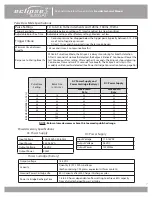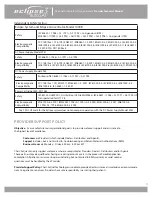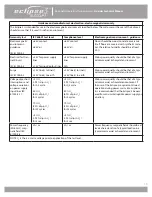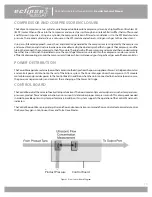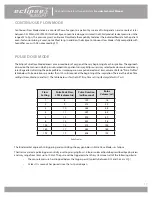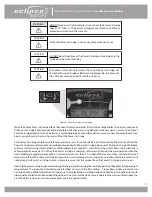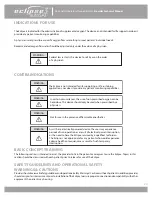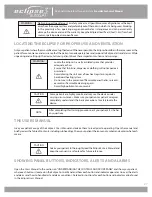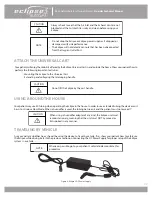
Personal Ambulatory Oxygen System
Provider Technical Manual
21
Figure 6: Eclipse 3 DC Power Supply
Located near the output cord, there is a green LED that is illuminated when the DC Power Supply is supplying 26VDC power.
If the LED is not illuminated, there is no input power available. The Power Supply contains protection circuits for output over-
current, input over-voltage, and internal over-temperature conditions. If any of these conditions exist, output power will be
interrupted and the LED will turn off. These three conditions are self-resetting, and output power will resume when protection
circuits fall back into acceptable operating ranges. The power supply will not charge the battery or operate the Eclipse above
2 LPM continuous or 96 mL in pulse dose while operating power on DC.
DO NOT
use the DC supply to power the Eclipse once the vehicle’s engine is turned off as this may drain the car’s battery.
POWER CARTRIDGE (BATTERY)
The Power Cartridge allows operation away from AC or DC power. The Power Cartridge used with the Eclipse contains Lithium
ion battery cells, similar to those used in laptop computers and cell phones. The Eclipse Power Cartridge contains a quantity of
two 97.5 Watt hour battery packs. Each battery pack contains 7.92 grams of equivalent lithium content.
Figure 7: Eclipse 3 Power Cartridge
The Power Cartridge (Battery) may be charged in two ways: (a) place the Power Cartridge in the Eclipse and connect the Eclipse
to AC power, or (b) place the Power Cartridge in the optional Desktop Charger (PN 7112-SEQ).
Operating and servicing the Power Cartridge will ensure longer life and higher performance. It is important to follow the tips
and recommendations when storing and operating the Eclipse on the Power Cartridge.

